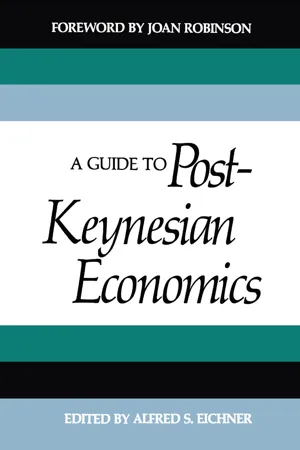Economics
Income and Substitution Effect
The income effect refers to the change in quantity demanded of a good due to a change in real income, holding prices constant. The substitution effect refers to the change in quantity demanded of a good due to a change in relative prices, holding real income constant. Both effects are important in understanding consumer behavior and the impact of price changes on consumption patterns.
Written by Perlego with AI-assistance
Related key terms
9 Key excerpts on "Income and Substitution Effect"
- eBook - ePub
- Tibor Scitovsky(Author)
- 2013(Publication Date)
- Routledge(Publisher)
The purpose of separating the effect of a price change on consumer’s demand into two parts is that it enables us to say a little more about the nature of this change than we could say otherwise. It is apparent, to begin with, that the substitution effect, which results from a movement along an indifference curve, always pulls in the same direction. The substitution effect of a fall in price tends always to raise demand and that of a rise in price tends always to lower demand for the good whose price has changed. We can also tell that, the closer substitutes there are for the good in question, the greater the substitution effect will be; and that it will be zero if there are no substitutes at all.As to the income effect, no general statement can be made about its direction. We have shown that a price reduction is equivalent to a rise in income; but a rise in income may raise, lower, or leave unchanged the consumer’s demand for a good. Accordingly, the income effect of a price reduction may also raise, lower, or leave unchanged the consumer’s demand. In the first case, where a rise in income would raise demand, the income effect and substitution effect of a price change are additive. This was illustrated in Figure 10 . In the last case, where a change in income would leave demand unchanged, the income effect is zero; and the only effect of a price change is its substitution effect. In the second case, where a rise in income would lower demand, income effect and substitution effect pull in opposite directions; and the total effect of a price change is the difference between the two. This happens in the case of inferior goods. For example, a fall in the price of bread tends to induce the consumer to substitute bread for other forms of food and so adapt his marginal rate of substitution between bread and other foods to the changed ratio of their market prices. At the same time, however, the fall in the price of bread renders the consumer better off than he was before and enables him to consume his calories in the form of more expensive foods. Whether, on balance, the fall in the price of bread will make him buy more or less bread depends on whether the substitution effect is greater or smaller than the income effect. The factors determining the substitution effect have been discussed above; the magnitude of the income effect depends mainly on the importance of the commodity in question in the consumer’s budget. A given fall in the price of a commodity will make the consumer the better off the more he spends on the commodity; and the better off he becomes, the more his demand will be affected by the change. The fall in the price of bread, therefore, will have a large income effect on the demand of a person with a very low income, whose expenditure on bread looms large in his budget. Only in his case is the income effect likely to exceed the substitution effect and cause his demand for bread to fall as the price of bread falls.20 - eBook - ePub
Economics
The Definitive Encyclopedia from Theory to Practice [4 volumes]
- David A. Dieterle, David A. Dieterle(Authors)
- 2017(Publication Date)
- Greenwood(Publisher)
Producers and retailers use the identity of a good as a luxury, necessity, or inferior good during the advertising process. There seems to be very little advertising for necessities because consumers purchase these goods regardless of their income. Advertisements for luxury goods are most often targeted to audiences with substantial disposable incomes. It is almost comical to imagine an advertisement for an expensive car or other luxury item in an impoverished area. Impoverished communities would most likely be exposed to advertisements for inferior goods such as Ramen noodles, bus tickets, or canned food. Likewise, it would be rare to see these items advertised in wealthy communities.There is extensive research on the income elasticity of most broadly defined goods and services. A quick Internet search will reveal multiple interesting topics, such as the income elasticity of health care, environmental protection, antipoverty policies, and essential nutrients. Perhaps the most interesting is the income elasticity of environmental protection, which suggests that only relatively wealthy countries are willing to pay the cost of protecting the environment while relatively poor countries are not. Income elasticity is a fascinating topic that often reveals the behaviors of consumers as a group.Xavier WhitacreSee also: Demand; SupplyFurther ReadingAndreyeva, Tatiana, Michael Long, and Kelly Brownell. 2010. The impact of food prices on consumption: A systematic review of research on the price elasticity of demand for food. American Public Health Association 100 (2): 216–22. http://www.ncbi.nlm.nih.gov/pmc/articles/PMC2804646// (accessed February 17, 2014).Frank, Robert. 2009. The economic naturalist’s field guide. New York: Basic Books.INCOME VERSUS SUBSTITUTION EFFECTSWhen studying demand and the causes that affect demand, we need to take into consideration both the Income and Substitution Effects on the law of demand. The two patterns of behavior overlap when studying why consumers demand the goods and services that they consume. Both the substitution and income effects can modify consumers’ spending patterns. Together they explain why an increase in price decreases the quantity purchased.Income EffectWhen the price of an item changes, but a consumer’s income remains the same, this will affect the quantity of a given good (for example, candy bars) purchased by that consumer. As the price of a candy bar rises (or falls) and the consumer’s income holds steady, the amount of candy bars consumed will fall (or rise). This is known as the income effect reinforcing the law of demand. - eBook - ePub
Economics for Investment Decision Makers
Micro, Macro, and International Economics
- Christopher D. Piros, Jerald E. Pinto(Authors)
- 2013(Publication Date)
- Wiley(Publisher)
We see that for inferior goods, the income effect and the substitution effect are in opposite directions: The decrease in price causes the consumer to buy more, but the income effect tends to mitigate that effect. It’s still true that a decrease in the price of bread represents an increase in real income. But in the case of an inferior good, the increased income causes the consumer to want to buy less of the good, not more. As long as the income effect has a lower magnitude than the substitution effect, the consumer still ends up buying more at the lower price. However, the consumer buys a little less than she would if the good were normal. It is possible, though highly unlikely, for the income effect to have greater magnitude than the substitution effect. We examine that case next.In the case of savings, the same type of effects can apply. For example, say interest rates rise. Individuals may save more because the reward (price) for saving has risen, and individuals substitute future consumption for present consumption. However, higher interest rates also imply that less saving is required to attain a given future amount of money. If the latter effect (the income effect) dominates, then it is possible to observe higher interest rates resulting in less savings.6.4. Negative Income Effect Larger than Substitution Effect: Giffen Goods
In theory, it is possible for the income effect to be so strong and so negative as to overpower the substitution effect. If that were to occur, then a decrease in price could result in a decrease in quantity demanded and a positively sloped individual demand curve. Let us explore this curiosity in Exhibit 2-18 .EXHIBIT 2-18 Income and Substitution Effects for a Giffen GoodNote: Income and Substitution Effects of a fall in price for a Giffen good: When price declines, the consumer chooses to buy less of the good.Once again, we decrease the price of bread as indicated by the pivoting of the budget constraint form BC 1 to BC 2 , and then we move the budget constraint parallel to itself leftward until it just touches the original indifference curve at point b to remove the income effect. What is left is the substitution effect. As always, the substitution effect causes the consumer to substitute more bread for less wine in the basket, as indicated by the movement along the indifference curve from point a to point b . But notice the odd result when we “give back” the income and move from BC 3 to BC 2 . The income effect for this inferior good (from point b to point c ) is once again opposite in direction to the substitution effect, as is true for all inferior goods. But in this curious case, its magnitude overwhelms the substitution effect: point c lies to the left of point a . The consumer actually buys less of the good when its price falls, resulting in a positively sloped demand curve. If we reversed the analysis and increased the price of bread, this consumer would buy more bread when its price rose. Those inferior goods whose income effect is negative and greater in magnitude than the substitution effect are known as Giffen goods - eBook - ePub
- John H Hoag(Author)
- 2012(Publication Date)
- WSPC(Publisher)
What we want to do is to somehow separate the two forces that are causing demand to have a negative slope. One of the reasons has to do with income apparently changing. We might say that real income changed even though money income did not. What we need is a definition of real income that will allow us to know when it is changing and when it is not. On the one hand, we could use some kind of price index as we do in macro. But a more fruitful way to proceed is to think that as long as the well-being of the consumer does not change, the consumer’s real income has not changed. We measure well-being by utility, so if utility does not change, real income does not change.Definition 3.2: We say that two bundles represent the same real income if they are on the same indifference curve, have the same utility.Substitution occurs when the price of one good changes relative to the price of another good. Hence, the impulse to substitute must be related to how expensive one good is compared to another.Definition 3.3: We say that the ratio of relative prices (the relative price ratio or relative prices) is the ratio of the price of X to the price of , Px /Py .Exercise 1. Where do you see the relative price ratio in the consumer’s problem? Be specific!We can now state the definitions of the two effects we described above.Definition 3.4: The income effect is that part of the movement along demand due to a change in real income with relative prices held fixed. We denote the income effect as .Note that in the denominator of the income effect, we have , not represents a change in real income, the indifference curve, not a change in money income, M.We are now ready for the remaining effect, the one due to substitution.Definition 3.5: The substitution effect is that part of the movement along demand due to a change in relative prices with real income held fixed. We denote the substitution effect as .The question is, how can we find these effects? Let us go back to the original derivation of demand. Look again at Figure 3.1 . The initial utility maximization point is at W when the price of X is Px. When the price of X falls to , the new utility maximization point is at V. How are the real income and relative prices different at V compared to W?At W, the relative prices are Px /Py. At V, the relative prices are . What about the real income? We are using the indifference curve to measure real income, so the real income at W is I1 , and at V real income is I2 - eBook - ePub
- Alfred S. Eichner, Alfred S. Eichner(Authors)
- 2023(Publication Date)
- Routledge(Publisher)
As the neoclassical orthodoxy gradually gives way to a post-Keynesian approach, the nature of economics as an intellectual discipline is likely to change in three important ways. At the most obvious—though not necessarily the most fundamental—level, the emphasis is likely to shift from the analysis of substitution effects to the analysis of income effects. The Walrasian model which forms the core of neoclassical theory encompasses little more than substitution effects. Within the logic of the model, the demand for one good can increase only at the expense of the demand for another good, and then only because the relative price of the former has fallen. Similarly, one type of input, such as capital goods, can be used more intensively in the production process only at the expense of another type of input, such as labor, and then again only because the relative price of the former has fallen. This approach usually eliminates by assumption the possibility that the demand for all goods and the use of all types of inputs may increase together—at differing rates, to be sure—as a result of the higher income and level of demand which economic growth brings with it. Reliance on the neoclassical model makes it difficult, therefore, to provide a plausible and coherent explanation of economic growth.In the more sophisticated versions of neoclassical theory, some income effects, it is true, are allowed for. But still, it is the substitution effects arising from a change in relative prices which provide the impetus for the shift from one static equilibrium position to another, and thus it is only the substitution effects which make any real difference in the models. In contrast, the economists responsible for developing the post-Keynesian alternative have found that, if a plausible and coherent explanation for such real-world phenomena as economic growth and cyclical fluctuations is to be provided, it is not enough simply to take into account the income effects, making them an integral part of the analysis. It is also necessary to recognize that the income effects generally swamp the substitution effects—if they do not eliminate them altogether.Keynes (1936) - eBook - ePub
- Stanley Bober(Author)
- 2016(Publication Date)
- Routledge(Publisher)
There is evidence to support our point of view. The price elasticities of such basic items as clothing and housing are very small, being 0.49 and 0.01 respectively. And for a group of diverse items such as medical care, gasoline, legal services, eggs, and telephone service, we have numbers ranging from a low of 0.1 (eggs) to a high of 0.37 (legal services). Certainly we see very small substitution effects. Now Principles texts offer up the usual explanations in terms of the cost of the good as a proportion of income, whether the good can be substituted for (generally, as we pointed out, it cannot be); though at times one finds a butter-margarine example as a substitutable case. But we would argue that in the modern world these are, overall, not considered as perfectly substitutable in the light of medical findings and particular cooking needs. As well, different elasticities are explained in terms of whether the good is necessity or luxury (presumably the counterpart to needs and wants). Yet this explanation only reflects the static nature of the argument. In an economically changing world where incomes are increasing over time, what is a luxury at one point in time quickly becomes a necessity at another. Even for such a presumed luxury item as foreign travel, the elasticity coefficient is approximately unity.We would conclude that the conventional rationale to account for a small price substitution effect misses the basic point, which is that in the main, consumer expenditures are for goods that have different characteristics, fulfilling different needs and cannot be substituted one for another. Thus the fundamental point that variations in their relative prices will evidence no change in consumer behavior, or very small ones. There is a study that points out that with eighty categories of consumer goods, expenditures are mainly determined by habits and income effects, while that price-substitution effect plays a most modest role.19
Now that we have a realistic framework in place we want to diagram this nonprice emphasis, and also draw some different “rules” underpinning an understanding of the consumer.Different Diagrams and Different RulesIt is the level of real income that is the relevant and critical variable; in the main, a change in the price level is responded to via its effect on real income. Recall our basket-stacking–levee image, where it is the level of real income that determines the height of the levee and the fullness of the basket in relation to habit and convention. The connection between the proportion of one’s income spent on the various goods composing the different baskets (thereby satisfying different needs) and the change in the level of real income can be depicted via Engel curves. - eBook - ePub
- D Sapsford(Author)
- 2013(Publication Date)
- Routledge(Publisher)
In the current example the wage rate, and therefore the price or opportunity cost of leisure relative to market work, has risen, and the substitution effect encourages the worker to decrease his consumption of the now relatively more expensive good (i.e. leisure) by the amount (L 1 — L C) hours per day. In cases where indifference curves are convex to the origin, the substitution effect must always be negative ; that is, it must encourage reduced consumption of the good whose price has risen. (See, for example, Laidler, 1974, p. 24.) This is easily seen from Figure 2.2 by noting that, because A and C are tangency points, the slope of I 1 at these points is given by w and w 1 respectively. Since I 1 is convex to the origin, the absolute value of its gradient increases as we move around it from right to left; and consequently, since w x exceeds w, C must lie to the left of A, which means that the substitution effect of a wage increase must induce the worker to substitute market work for leisure. The movement from C to B denotes the income effect, and it illustrates the worker's response to an increase in real income — or, more precisely, in utility — with relative prices held constant. If leisure is a normal good (i.e. one having a positive income elasticity of demand), the income-consumption curve (CB) will have a positive slope, showing that, as income rises, consumption of leisure increases, in this case by the amount (L 2 — L C) hours per day. Provided that leisure is a normal good, the Income and Substitution Effects of a wage change work in opposite directions, with the negative substitution effect encouraging the worker to substitute work for leisure, while the positive income effect encourages him to substitute leisure for work. In the current example the net effect of the increase in the wage rate from w to w 1 is to decrease leisure consumption (i.e. increase market work) by (L 1 — L 2) hours per day - eBook - ePub
- Fritz Machlup(Author)
- 2013(Publication Date)
- Routledge(Publisher)
The immediate initial adjustment of the trade balance to changes in the terms of trade is not entirely an income effect in the sense of the Hicksian theory of the household. In the Hicksian analysis of consumer’s choice the total effect of an increased buying price is interpreted as the combined effect of substitution and real-income change. For example, the decision in response to a price increase to take less of the commodity and to keep more or less money is partly a substitution between the commodity and money, partly an effect of the reduced real income upon both. If only income effects are taken into account while substitution effects are ignored, serious errors will ensue.This is fully applicable to international trade and to aggregate absorption by the community. There are substitutions between asset holdings (or debt) and imported producer and consumer goods that occur along with, and in addition to, the income effects of changes in the terms of trade.32 These substitution effects may significantly affect the absorption of income and the physical volumes of imports and exports; these are price-induced changes in absorption which are not included in any given “propensity to absorb.”The terms-of-trade effects on the trade balance should include these substitution effects. If one presumes with Alexander that ΔB = ΔY, even if only “initially,” the substitution effects are conjured away or at least lost sight of.THREE SEPARATE EFFECTS ON INCOME?In Alexander’s analysis, as also in Harberger’s, devaluation could affect real income in only two ways: by changing the volume of employment and by changing the commodity terms of trade. The possibility of affecting real income through a reallocation of resources was ignored. Hence I proposed to add to the “idle-resources effect” and the “terms-of-trade effect” a third one, the “resource-reallocation effect” of devaluation upon income and absorption, and thus upon the trade balance.33But this analytical separation of income effects may be misleading: it may suggest that it is possible to separate them practically and perhaps to manage to avoid a negative income effect without foregoing the benefit of a positive one. Often a negative “terms-of-trade” effect is the condition of the realization of positive “idle-resources” or “resource-reallocation” effects. As was said above, the exclusive attention to the commodity terms of trade (in disregard of the single factor terms) has been associated with the failure to consider the effects of resource reallocation as a factor relevant to the end results. It can be shown that attempts to isolate, in the analysis of devaluation, changes in the commodity terms of trade and to exhibit them for separate or comparative evaluation may obstruct our understanding of the interrelationships involved. - eBook - ePub
Foundations of Macroeconomics
Its Theory and Policy
- Frederick S. Brooman(Author)
- 2017(Publication Date)
- Routledge(Publisher)
16 and it cannot be claimed that the permanent income hypothesis, any more than the MBA life-cycle theory, has gained universal acceptance as yet. Even so, they are particularly instructive in showing possible ways in which consumers’ decisions may be affected by expectations as well as by current income, and they have provided a useful stimulus to research on the nature of the consumption function.6. Chanes in the Price Level
The consumption function was defined earlier (p. 100) in terms of real income and consumption, not in terms of money values, which may alter solely because of price changes. Since National Product is necessarily equal in value to National Income, a rise in prices must increase both in the same proportion. It may seem, therefore, that a 10% rise in the general price level will give consumers 10% more money income to spend on commodities that are 10% more expensive on the average, and so they may be expected to consume the same proportion of income as before, leaving the situation unchanged in real terms. Nevertheless, price changes are likely to affect consumers’ decisions in a number of ways.To begin with, a change in the general price level is unlikely to involve an equal proportionate change in the price of each single commodity; for example, food prices may rise only 5% while clothing prices rise 15%. If consumers react by buying less clothing (because it is relatively, as well as absolutely, more expensive) but go on buying about the same quantity of food (even though it is relatively cheaper ), total consumption will fall in real terms.Second, a change in National Income does not necessarily mean an equal change in personal disposable incomes. When prices rise, firms receive more money for the commodities they produce; but they retain it (for the time being, at any rate) as undistributed profits, so that it does not get into the hands of personal consumers. Even if it does all pass into personal incomes, the recipients may find themselves pushed into higher tax brackets under a system of progressive income taxation; their disposable incomes will then rise by a percentage smaller than the rise in National Income. When prices fall, these effects will of course be reversed.
Learn about this page
Index pages curate the most relevant extracts from our library of academic textbooks. They’ve been created using an in-house natural language model (NLM), each adding context and meaning to key research topics.








